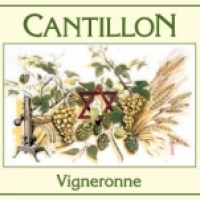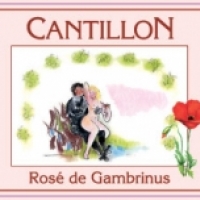Comprar Cantillon Iris - Cantillon Vigneronne - Cantillon Rosé de Gambrinus
The Cantillon brewery is closely linked to Brussels, a city which has the iris as its symbol. As the name indicates, the "marsh iris" is a plant growing in humid areas. The historical center of Brussels is built on swamps where this flower used to grow abundantly.
In 1998, the Brussels Museum of the Gueuze celebrated its 20th anniversary. The Cantillon brewery decided to make a new spontaneous fermentation beer for this occasion, named after this symbolic flower.
It is a completely original beer which, contrary to the other products of the Brewery, is not brewed with 35% of wheat. The Iris, which is only made with malt of the pale ale type (giving a more amber colour to the beer) conserves the typical flavour of the spontaneous fermentation, the complex aromas and the vinous taste.
The hopping is different too. Lambic is made with 100% dried hops, for the Iris we use 50% of dried hops and 50% of fresh hops. The latter cause a superb acidity, the former, due to their tannins, enable to conserve the beer while preserving all its qualities.
After two years in the barrel, the Iris undergoes a second fresh hopping two weeks before the bottling. A linen bag, filled with hops, is soaked in the beer for two weeks. This technique, called "cold hopping", gives the beer a more intense savour and makes the smell and the taste more bitter.
The lambic brewers weren't only established in the Senne valley, but also in the valley of the Yssche . This small river has its spring in the Forêt de Soignes and flows through villages like Hoeilaart, Overijse and Huldenberg. In this valley there used to live many brewers who made delicious lambic.
They didn't add cherries or raspberries to their beer, but grapes which had been cultivated in greenhouses. By blending muscat grapes and lambic, the brewers and beer merchants produced the "druivenlambik" (grapes lambic).
In 1973, Jean-Pierre Van Roy, after having relaunched successfully the production of raspberry lambic, bought white grapes and soaked them in lambic. This experiment was successful too. The fructose, which abounds in these fruits, enables us to make a beer which is more mellow than the Gueuze or the other fruit beers.
The name Vigneronne Cantillon was given in 1987. This name reminds us that, while it belongs to the beer patrimony, the spontaneous fermentation, the ageing in the barrels for several years and the addition of grapes make it a distant cousin of certain white wines.
In spite of its success, the Vigneronne represents less than 5% of the total production of the Cantillon brewery. In order to obtain grapes which are as mature as possible, we buy them at the end of the season. Every year, 1000 kilos of white italian grapes are delivered at the Cantillon brewery in the beginning of October.
It is difficult to produce more Vigneronne even though the demand exists. All the grapes are picked from the bunch by hand and we don't have much time, since the new brewing season starts at the end of October.
The beers are not blended before the bottling. The second fermentation is caused by the addition of a sugared liquor. The six-pointed star on our label is an alchemist's symbol. It contains four elements, represented by triangles, of the brewing process. The fire is the symbol of the mashing tun, the earth of the cereals, the air of the yeasts, and the water is the fourth element. At this moment, only a brewer of traditional lambic may use this symbol.
Rosé de Gambrinus
Assemblage de Lambics et de framboises à raison de 200 g par litre.
Bière au goût acidulé, fruité et parfumé.
Tout comme pour la Kriek, le Rosé de Gambrinus présentera un maximum de "fruité" s’il est dégusté jeune. L’âge permettra en effet au Lambic de pleinement s’exprimer et ce, au détriment du fruit.
----------------------------
A diferencia de las Kriek, que ya existían durante el s.XIX, es más difícil de determinar la aparición de las Lámbicas elaboradas con frambuesa.
En 1909 esta cerveza ya estaba en el catálogo de Cantillon y tras desaparecer durante la primera Guerra Mundial, reaparecer y volver a desaparecer durante la década de 1930, en 1973 volvió la producción por un reparto de 150 kg de frambuesas por parte de Willy Gigounon, con lo cual 40 años después se volvía a elaborar.
- Alhambra Tradicional - Heineken H41
- Domus Super Aurea - Fort So Solid - Anchor Double Liberty IPA
- Mahou Cinco Estrellas - Paulaner Münchner Hell / Münchner Lager / Original Munich Lager
- Ayinger Celebrator - Ayinger Urweisse - Ayinger Weizenbock
- San Amaro Dark Ale - San Amaro Pale Ale - San Amaro Navidad 2010
- Estrella Galicia Especial - Alhambra Especial - Moritz
- Bou Bou - Zerep Tostada - La Pirata Sansa Amber Ale
- Estrella Galicia Especial - Guinness Draught
- Kross 5 - Kross Golden - Kross Maibock
- Biere de Miel - Delirium Tremens - De Graal Dubbel
- Barcelona Beer - Barcelona Beer Company Miss Hops - Barcelona Beer Company Sr. Lobo
- Montseny Castanya - Birres Ribes Grogaina - Tibidabo Brewing Joy Bomb
- Acacia Ale Cobriza - Er Boquerón - La Esmeralda Especial
- Leffe Blonde - Leffe Royale - Leffe de Noël
- Delirium Nocturnum - Anosteké Prestige
- Victoria - Grupo Modelo - Corona Extra - Negra Modelo
- Stella Artois - 961 Beer Lager
- Anchor Porter - Ballast Point Pale Ale
- Singha - Peroni Nastro Azzurro - Estrella Damm
- Cristal - Palma Cristal - Cristal Perú
- Waterloo Cuvée Impériale - Slaapmutske Tripel - Straffe Hendrik Brugs Tripel Bier 9°
- Delirium Red - Keltius In Peccatum Corazón de Ribeiro - Modern Times Fruitlands Passion Fruit & Guava
- Damm Lemon - Voll-Damm - Damm Navidad
- Victoria - Grupo Modelo - León - Superior
- Santocristo Castaña Asada - Doménicus Rubia - Keltius In Peccatum / Malte Estío
- Corona Extra - Budweiser - Cerveza Aguila
- Cruzcampo Cruzial - Ambar Radler
- Grolsch Premium Lager - Cervecería y Maltería Quilmes Andes Origen Rubia
- Glops d`Hivern - Farinetes Concordia - BBF 2015 Llúpol
- Lucky Beer (Lucky Buddha) - Tsingtao
- Medina La Vieja - Guápulo Suca
- Argus 100% Malta - Mercadona Doble Malta
- Navaliega - Sevebrau Weizen - La Masovera Pubilla
- Young´s Double Chocolate Stout - St. Peter’s Old Style Porter
- Modelo Especial - Indio - Modelo Ambar
- Porterhouse Wrasslers 4X - Porterhouse Slurpasaurus - Guinness Nitro IPA
- St. Bernardus Abt 12 - Vleteren Bruin 12° Oak Barrel Aged - La Quince / Sanfrutos Belle Framboise
- Cas Cerveser Garaje Red Ale - Curaka Red Ale - Bermeja Red Ale
- Tsingtao - Sapporo Premium Beer - Asahi Super Dry
- Estrella Damm - Cruzcampo Fresca
- Dougall’s 942 IPA - Dougall’s Invierno - Dougall’s IPA 1
- Blanche de Namur - Concordia Aria Witbier - De Brabandere Brewmaster’s Selection Wild Funky Wit
- BrewDog Albino Squid Assassin - BrewDog Prototype Black IPA - BrewDog Tactical Nuclear Penguin
- Voll-Damm - Corona Extra - C5 Saga
- Corona Extra - Victoria - Grupo Modelo - Negra Modelo
- Negra Modelo - Modelo Especial - Noche Buena
- Voll-Damm - Amstel Extra - Mercadona Doble Malta
- Mikkeller Nuclear Hop Assault - Mikkeller Hoppy Lovin’ Christmas - Mikkeller Crooked Moon Tattoo dIPA
- Coisbo Brooklyn Fall - Coisbo Astoria Black
- La Quince 15 Hours Session IPA Athanum - Bertus White IPA - Old Skull Lúpulo Bravo
- Mahou Negra - Mahou Maestra Dunkel
- Mahou Cinco Estrellas - Mahou Clásica - Cruzcampo Fresca
- Tripel Karmeliet - Goliath Winter - Kapittel Blond
- Imperial IPA - Schneider Roja
- El Inca Bicervecina - Maltín - Corona Extra
- Voll-Damm - Argus Especial - Damm Inedit
- Grimbergen Triple - Chimay Grande Réserve (Blue)
- Stella Artois - Budweiser Budvar / Czechvar Original
- Estrella Galicia 1906 Reserva Especial - La Milnueve - Estrella Galicia Especial - Mahou Maestra
- Gran de Select Vintage Cristian - El Santuari Santu Triple























